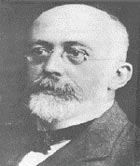Archival Notice
This is an archive page that is no longer being updated. It may contain outdated information and links may no longer function as originally intended.
Home | Glossary | Resources | Help | Contact Us | Course Map
In 1908, two scientists, Godfrey H. Hardy, an English mathematician, and Wilhelm Weinberg, a German physician, independently worked out a mathematical relationship that related genotypes to allele frequencies.05
Their mathematical concept, called the Hardy-Weinberg principle, is a crucial concept in population genetics. It predicts how gene frequencies will be inherited from generation to generation given a specific set of assumptions.06 The Hardy-Weinberg principle states that in a large randomly breeding population, allelic frequencies will remain the same from generation to generation assuming that there is no mutation, gene migration, selection, or genetic drift.04 This principle is important because it gives biologists a standard from which to measure changes in allele frequency in a population.
To illustrate how the Hardy-Weinberg principle works, let us consider the MN blood group. Humans inherit either the M or the N antigen, which is determined by different alleles at the same gene locus. If we let the frequency of allele M=p and the frequency of the other allele N=q, then the next generation's genotypes will occur as follows:
- Frequency of MM genotype = p2
- Frequency of MN genotype = 2pq
- Frequency of NN genotype = q2
We can take a sample of the population and count the number of people with each genotype. For example, a sample of 5000 from Forensic Town, USA, has:
- 1460 individuals of type MM, that is 1460/5000 or 29.2%
- 2550 of type MN, that is 2550/5000 or 51%
- 990 of type NN, that is 990/5000 or 19.8%
If we apply the Hardy-Weinberg equation (p2 + 2pq + q2 = 1), we can calculate the allele frequencies as:
- Frequency of M = p2 + 0.5 (2pq) = 0.292 + (0.5 x 0.51) = 0.547
- Frequency of N = q = 1 - p = 1 - 0.547 = 0.453
We can now calculate our expected genotype frequencies:
- MM = p2 = 0.5472 = 0.299, or 1496 individuals in the sample
- MN = 2pq = 2x0.547x0.453 = 0.496, or 2478 individuals
- NN = q2 = 0.4532 = 0.205, or 1026 individuals
When a population meets all of the of the Hardy-Weinberg conditions, it is said to be in Hardy-Weinberg equilibrium (HWE). Human populations do not meet all of the conditions of HWE exactly, and their allele frequencies will change from one generation to the next and the population will evolve. How far a population deviates from HWE can be measured using the "goodness of fit" or chi-squared test (χ2).
Applying the above data to the chi-square test gives:
- χ2 = [(990 - 1026)2 / 1026] + [(2550 – 2478)2 / 2478] + [(1460-1496)2 / 1496]
- χ2 = [1296 / 1026] + [5184 / 2478] + [1296 / 1496]
- χ2 = [1.263] + [2.092] + [0.866] = 4.221
To determine what this chi-squared value means, we must next look at a chi-squared distribution table.
View the chi-squared distribution table.
There is a document attached of type pdf.
If you do not have a program to open files of type pdf, you can get one here.
Since we have two alleles, we therefore have 3 minus 1, or 2 degree of freedom. Degrees of freedom is a complex issue, but we could look at this in simple terms: if we have frequencies for three genotypes that are truly representative of the population then, no matter what we calculate for two of them, the frequency of the third must not be significantly different for what is required to fit the population.
Looking across the distribution table for 2 degrees of freedom, we find our chi-squared value of 4.221 is less than that required to satisfy the hypothesis that the differences in the O and E data did not arise by chance. Since the chi-squared value falls below the 0.05 (5%) significance cutoff, we can conclude that the Forensics Town population does not differ significantly from what we would expect for Hardy-Weinberg equilibrium of the MN blood group.
Additional Online Courses
- What Every First Responding Officer Should Know About DNA Evidence
- Collecting DNA Evidence at Property Crime Scenes
- DNA – A Prosecutor’s Practice Notebook
- Crime Scene and DNA Basics
- Laboratory Safety Programs
- DNA Amplification
- Population Genetics and Statistics
- Non-STR DNA Markers: SNPs, Y-STRs, LCN and mtDNA
- Firearms Examiner Training
- Forensic DNA Education for Law Enforcement Decisionmakers
- What Every Investigator and Evidence Technician Should Know About DNA Evidence
- Principles of Forensic DNA for Officers of the Court
- Law 101: Legal Guide for the Forensic Expert
- Laboratory Orientation and Testing of Body Fluids and Tissues
- DNA Extraction and Quantitation
- STR Data Analysis and Interpretation
- Communication Skills, Report Writing, and Courtroom Testimony
- Español for Law Enforcement
- Amplified DNA Product Separation for Forensic Analysts



